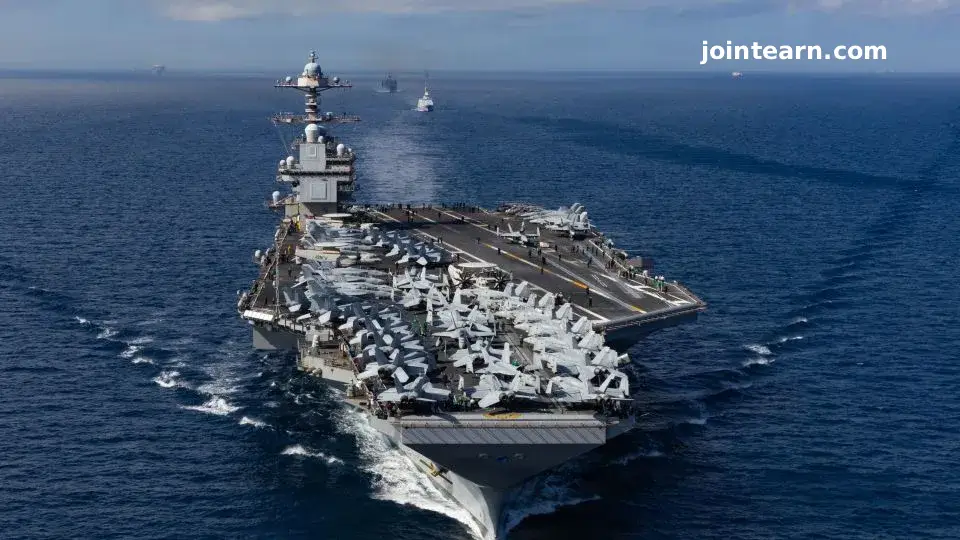
Washington, D.C. — October 25, 2025:
The USS Gerald R. Ford, hailed by the U.S. Navy as “the most capable, adaptable, and lethal combat platform in the world,” is being deployed to the Caribbean Sea as the Trump administration increases military pressure on Venezuela amid rising tensions and allegations of large-scale drug trafficking operations.
The Ford’s redeployment marks a significant escalation in U.S. military presence near Latin America and underscores Washington’s resolve to confront what it describes as “state-linked narcotics networks” tied to the Venezuelan government.
The World’s Most Advanced Warship
With a displacement of over 100,000 tons and stretching 1,100 feet (334 meters) in length, the USS Gerald R. Ford (CVN-78) is the largest and most technologically advanced aircraft carrier ever constructed. Commissioned in 2017, it is the first of the Ford-class carriers that will replace the Navy’s aging Nimitz-class fleet, the oldest of which is scheduled for decommissioning next year.
The Ford carries a crew of approximately 4,600 personnel, about 20% fewer than the Nimitz class, thanks to automated systems and advanced power management that reduce manpower needs while improving efficiency.
Its twin nuclear reactors, whose detailed specifications remain classified, deliver three times the electrical power of the Nimitz-class reactors. This surplus energy drives the carrier’s suite of next-generation systems, from electromagnetic catapults to digital weapons elevators.
EMALS: Revolutionizing Naval Aviation
At the heart of the Ford’s innovation is the Electromagnetic Aircraft Launch System (EMALS) — a magnetic catapult that replaces the traditional steam-powered launch mechanism. EMALS allows the ship to launch aircraft faster, with heavier payloads and longer range, dramatically increasing sortie rates and overall combat capability.
The ship’s 11 Advanced Weapons Elevators are also powered by electromagnetic motors, which enable rapid transfer of munitions from magazines below deck to aircraft topside, enhancing both speed and safety during combat operations.
Its Advanced Arresting Gear (AAG) — a digital aircraft recovery system — improves landing precision, allowing for greater operational tempo and reduced stress on airframes.
Expansive Flight Deck and Enhanced Air Operations
The Ford’s flight deck is four feet wider than that of the Nimitz class, and its island superstructure has been moved further aft to open up more space for aircraft operations. This redesign allows for smoother flight operations, quicker rearming and refueling cycles, and higher sortie generation rates.
Its air wing includes the battle-tested F/A-18 Super Hornet multirole fighter jets — capable of air-to-air, air-to-ground, and anti-ship missions with a combat range exceeding 1,250 miles (2,011 kilometers).
The carrier also deploys EA-18G Growler electronic warfare aircraft, E-2D Hawkeye early warning planes, and MH-60 Seahawk helicopters for anti-submarine and logistical operations.
However, the Ford has yet to be modified for the F-35C Lightning II, the Navy’s fifth-generation stealth fighter. Those upgrades are planned for a future maintenance period, according to Navy officials.
A Strategic Deployment Amid Venezuela Standoff
The decision to deploy the Ford to the Caribbean theater comes amid growing tensions between Washington and Venezuelan President Nicolás Maduro’s government, which the United States accuses of sheltering criminal cartels and drug traffickers.
The Trump administration has signaled a tougher stance toward Caracas, with defense analysts noting that the Ford’s presence could serve as both a deterrent and a projection of U.S. naval power in the Western Hemisphere.
A Pentagon official, speaking anonymously, said the deployment would support “enhanced maritime surveillance, counter-narcotics missions, and freedom of navigation operations in international waters.”
A Long Journey to Operational Readiness
The USS Gerald R. Ford’s path to full combat readiness has not been without obstacles. Despite being commissioned in 2017, the ship did not make its first deployment until 2022 due to technical challenges with its electromagnetic systems and weapons elevators.
Its first combat deployment took place in 2023, when it was sent to the eastern Mediterranean following the Hamas-led attacks on Israel. During that mission, the Ford played a central role in U.S. deterrence operations and air patrol missions in support of regional allies.
Since then, the Navy has worked to refine its systems and increase reliability, positioning the Ford as a symbol of next-generation American naval dominance.
Power Projection in a Changing Global Order
The deployment of the Ford to the Caribbean highlights how the U.S. Navy is adapting to an increasingly multipolar world. With China expanding its naval footprint and Russia reasserting influence in the Atlantic and Arctic, Washington’s show of force near Venezuela signals its intent to maintain strategic control of the Western Hemisphere.
Defense experts say the Ford’s presence could reassure allies in the region, such as Colombia and Panama, while warning adversaries that the United States remains capable of rapid, overwhelming response to regional threats.
“The Ford isn’t just a warship — it’s a floating city of deterrence,” said defense analyst Eric Rainsford. “Every deployment sends a message about American reach and resilience.”
As the world’s largest nuclear-powered aircraft carrier, the USS Gerald R. Ford now heads toward the Caribbean — its advanced systems, cutting-edge aircraft, and 4,600-strong crew embodying the most powerful symbol of U.S. naval supremacy in the modern era.


Leave a Reply